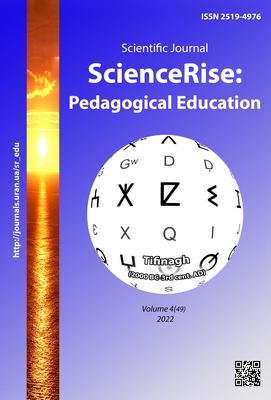Можливості персонального навчального середовища для здійснення самоосвітньої діяльності майбутнього працівника фармації
DOI:
https://doi.org/10.15587/2519-4984.2022.261052Ключові слова:
персональне навчальне середовище, моделі PLE, можливості ІКТ, самоосвітня діяльність, майбутній працівник фармаціїАнотація
Висвітлено питання використання інформаційно-комунікаційних технологій в освіті студентів фармацевтичного напряму. Особливу увагу автором приділено важливості створення персонального освітнього середовища, який уможливлює самоосвітню діяльність студента та є підґрунтям для освіти протягом життя. Автором подано докладне потрактування феномену, підходи щодо нього та описано чотири моделі, які використовують у зарубіжній педагогічній практиці. Аналіз педагогічних студій дозволив стверджувати думку про потенціал PLE щодо розвитку самоосвітньої діяльності студента, зокрема майбутнього фахівця-фармацевта. Автором зазначені напрями використання інформаційних технологій щодо освіти медичного спрямування. Описані можливості певних елементів персонального освітнього середовища через призму їх задіяння в освітньому процесі, важливість розвивати уміння та активно користуватися одночасно низкою інформаційних ресурсів, систематизувати і порівнювати отримані знання, самостійно створювати нові джерела інформації. Визначено низку комп’ютерних та веб-технологій, які уможливлюють формування PLE, сприяють мотивації та розвитку самоосвітньої активності, а саме: використання структурування освітнього простору ЗВО на базі сервісів Ms Office365 та Ms Teams, хмарних сервісів MSO365; соціальних мереж Viber, Facebook і YouTube-каналів; комунікаційних платформ Zoom, Skype, Google Classroom, та інших; використання комп’ютерного моделювання фізичних, біологічних, хімічних, фізіологічних процесів, моделювання лабораторних робіт; використання електронних підручників; використання мультимедійних навчально-демонстраційних комп’ютерних програм, навчально-інформаційних відеофільмів; розробка сайту кафедри для розміщення на ньому організаційної та навчальної інформації; використання комп'ютерного тестування знань студентів та інтерактивної системи опитування. Автор наводить конкретні приклади з педагогічної практики, доводячи прямий зв’язок між інформаційно-комунікаційними технологіями, які наповнюють PLE, із розвитком самоосвітньої діяльності здобувача освіти
Посилання
- Morin A. (2021). Personalized learning: What you need to know. Understood. Available at: https://www.understood.org/en/articles/personalized-learning-what-you-need-to-know
- ELI 7 Things You Should Know ParentTopics: Teaching and Learning Digital Learning (2009). EDUCAUSE Learning Initiative (ELI) Collection(s). Available at: https://library.educause.edu/-/media/files/library/2009/5/eli7049-pdf.pdf
- Ledeneva, A. V. (2016). Personalnaia obrazovatelnaia sreda v magistrature. Innovatcionnye issledovaniia: problemy vnedreniia rezultatov i napravleniia razvitiia, 3, 27–32. Available at: https://cyberleninka.ru/article/n/kontseptsiya-proektirovaniya-personalnoy-obrazovatelnoy-sredy/viewer
- Dukhnich, Iu. (2011). Personalnaia sreda obucheniia. PLE.
- Harmelen, M. (2009). The Manchester Personal Learning Environment.
- Chatti, M. A. (2010). Personalization in Technology Enhanced Learning: A Social Software Perspective. AahenaUnivercity, 399.
- Michele, M. (2007). Supporting Personal Learning Environments: A Definition of a PLE. Available at: http://michelemartin.typepad.com/thebambooprojectblog/2007/08/supporting-pe-1.html
- FitzGerald, S. (2006). Creating Personal Learning Environment.
- Smolyak, V. (2017). The Content of Readiness of Future Elementary School Teachers for Use of the Personal Learning Environment. Pedahohika formuvannia tvorchoi osobystosti u vyshchii i zahalnoosvitnii shkolakh, 56-57, 496–503. Available at: http://nbuv.gov.ua/UJRN/Pfto_2017_56-57_65
- Buhaichuk, K. L. (2016). Blended learning: theoretical analysis and strategy of implementation in educational process of higher educational institutions. Informatsiini tekhnolohii i zasoby navchannia, 4 (54), 1–18. Available at: http://nbuv.gov.ua/UJRN/ITZN_2016_54_4_3
- Lytvynova S. H. (2016). Teoretyko-metodychni osnovy proektuvannia khmaro oriientovanoho navchalnoho seredovyshcha zahalnoosvitnoho navchalnoho zakladu. Kyiv.
- Morze, N., Spivak, S. (2017). Creating modern cloud-oriented personalized education environment taking into consideration educational process participants' ict competencies. Open educational e-environment of modern university, 3 (2017), 274–282. doi: http://doi.org/10.28925/2414-0325.2017.3.27482
- Fedortsova, O. (2021). Innovative Educational Practices and Their Use in Educational Institutions. New learning technologies, 95 (2021), 213–219. doi: http://doi.org/10.52256/2710-3560.95.2021.24
- Іvankova, N. A., Rizhov, O. A., Androsov, O. І. (2020). Algorithm for the formation of a personal learning environment by means of structuring theeducationalspace of the university based on Office365 and MS Teams services. Open educational e-environment of modern University, 9, 26–40. Available at: https://journals.indexcopernicus.com/api/file/viewByFileId/1180089.pdf
- Slepukhin, A. (2014). Ispolzovanie personalnoi obrazovatelnoi sredy v protcesse individualizatcii smeshannogo obucheniia studentov. Pedagogicheskoe obrazovanie v Rossii, 11, 195–198. Available at: https://cyberleninka.ru/article/n/ispolzovanie-personalnoy-obrazovatelnoysredy-v-protsesse-individualizatsii-smeshannogo-obucheniya-studentov
- Afanasiuk, O. I., Denesiuk, V. I. (2015). Natsionalna stratehiia pobudovy vnutrishnoi medytsyny na period 2015–2025 rr. Problemy ta perspektyvy vyshchoi medychnoi shkoly u rozrobtsi ta realizatsii natsionalnoi stratehii pobudovy novoi systemy okhorony zdorov’ia v Ukraini na period 2015–2025 rr. Vinnytsia, 7–8.
- Heagney M. (2013). What’s a “Clicker”? Teaching with New Technology. Available at: http://www.law.uchicago.edu/alumni/magazine/spring13/clicker
- Shelestova, A. (2021). The electronic education environment development with google classroom tools at the universities. Young Scientist, 4 (92), 240–244. doi: http://doi.org/10.32839/2304-5809/2021-4-92-51
##submission.downloads##
Опубліковано
Як цитувати
Номер
Розділ
Ліцензія
Авторське право (c) 2022 Kira Hnezdilova, Ruslana Barjadze

Ця робота ліцензується відповідно до Creative Commons Attribution 4.0 International License.
Наше видання використовує положення про авторські права Creative Commons CC BY для журналів відкритого доступу.
Автори, які публікуються у цьому журналі, погоджуються з наступними умовами:
1. Автори залишають за собою право на авторство своєї роботи та передають журналу право першої публікації цієї роботи на умовах ліцензії Creative Commons CC BY, котра дозволяє іншим особам вільно розповсюджувати опубліковану роботу з обов'язковим посиланням на авторів оригінальної роботи та першу публікацію роботи у цьому журналі.
2. Автори мають право укладати самостійні додаткові угоди щодо неексклюзивного розповсюдження роботи у тому вигляді, в якому вона була опублікована цим журналом (наприклад, розміщувати роботу в електронному сховищі установи або публікувати у складі монографії), за умови збереження посилання на першу публікацію роботи у цьому журналі.









